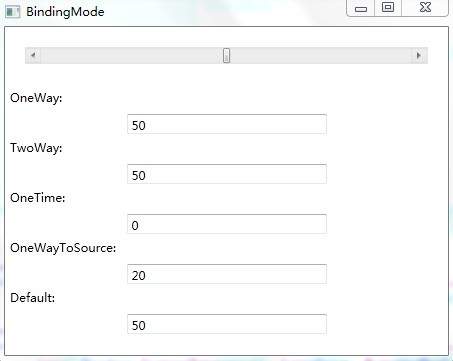源地址:http://www.cnblogs.com/zjz008/archive/2010/05/26/1744802.html
http://blog.csdn.net/haylhf/article/details/7628979
WPF支持OneWay,TwoWay,OneTime,Default和OneWayToSource等多种绑定模式
-
无论是目标属性还是源属性,只要发生了更改,TwoWay 就会更新目标属性或源属性。
-
OneWay 仅当源属性发生更改时更新目标属性。
-
OneTime 仅当应用程序启动时或 DataContext 进行更改时更新目标属性。
-
OneWayToSource 在目标属性更改时更新源属性。
-
Default:使用目标属性的默认 Mode 值。
下面的例子,展示了这几种绑定模式的区别:
 代码
<Window x:Class="WPF_Started.Controls.DataBinding.BindingMode"
代码
<Window x:Class="WPF_Started.Controls.DataBinding.BindingMode"
xmlns="http://schemas.microsoft.com/winfx/2006/xaml/presentation"
xmlns:x="http://schemas.microsoft.com/winfx/2006/xaml"
Title="BindingMode" Height="400" Width="300">
<StackPanel>
<ScrollBar Name="scroll" Orientation="Horizontal" Margin="20" Maximum="100" LargeChange="10" SmallChange="1" />
<Label Content="OneWay:" Height="30" />
<TextBox Name="scrollValue" Height="20" Width="200" HorizontalAlignment="Center"
Text="{Binding ElementName=scroll, Path=Value, Mode=OneWay}" />
<Label Content="TwoWay:" Height="30" />
<TextBox Name="scrollValueTwoWay" Height="20" Width="200" HorizontalAlignment="Center"
Text="{Binding ElementName=scroll, Path=Value, Mode=TwoWay}" />
<Label Content="OneTime:" Height="30" />
<TextBox Name="scrollValueOneTime" Height="20" Width="200" HorizontalAlignment="Center"
Text="{Binding ElementName=scroll, Path=Value, Mode=OneTime}" />
<Label Content="OneWayToSource:" Height="30" />
<TextBox Name="scrollValueOneWayToSource" Height="20" Width="200" HorizontalAlignment="Center"
Text="{Binding ElementName=scroll, Path=Value, Mode=OneWayToSource}" />
<Label Content="Default:" Height="30" />
<TextBox Name="scrollValueDefault" Height="20" Width="200" HorizontalAlignment="Center"
Text="{Binding ElementName=scroll, Path=Value, Mode=Default}" />
</StackPanel>
</Window>
运行结果显示,OneWay,TwoWay,Default模式下TextBox中的值随着滑块的位置而变化。OneTime模式下总是滑块的初始值0,这种模式下TextBox的值取决于ScrollBar的初始值。
OneWayToSource模式下,在TextBox中输入20,滑动条滑块会自动滑倒20的位置,但当滑动条继续滑动时候,该模式下TextBox的值并不随着滑动条的滑动而改变。
